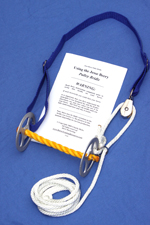“Monkey Rehab and Horse Training”
There was once a monkey in Bogota
Columbia that was trained to…
“Pick Pockets”
It was finally captured after com-
plaints from locals saying their cell phones,
wallets, and other valuables were stolen.
The police said after the monkey re-
turned home with the goods, it was rewarded
with bananas.
They took the monkey to an animal
rehab center.
Makes me wonder how you rehab a monkey
to stop stealing.
Just goes to show you an animal can
be trained to do remarkable things.
Horses are no exception.
But here’s what I find interesting.
When a horse continually does something
the owner doesn’t want, the horse was actually
trained to do it.
Yes…trained.
Admittedly, the horse wasn’t trained
to do it on purpose.
But he was trained to do it nonetheless.
I’ve said repeatedly you are always
training your horse even when you aren’t.
Often when a horse “seems” out of control
and needs lots of work, the owner gets
stuck and doesn’t know what to do.
It’s time for…
“Horse Rehab”
What is horse rehab?
Horse rehab is nothing more than simply
starting over with the horse and assuming that
he knows nothing.
That’s what most trainers do.
Bring a problem horse to a trainer and
they’ll make their assessment and likely “restart”
the horse from day one.
Why would a trainer do that?
Because the problem you see may only be
a symptom. The real problem may be happening
before the symptom shows up.
What’s an example?
Let’s see…
Once I had a horse that would rear up.
We’d ride around the barn a little and
then we’d head out.
Very soon she’d rear up.
Now you ask yourself, “is that the problem
or is it a symptom?”
Turns out it was the symptom…even though
rearing is a problem (but not THE problem).
You may have already guessed it, but the
horse just didn’t want to leave the barn.
So I thought that was fine – we don’t
have to leave the barn. But if we stay, we’re
gonna work our butts off.
Thus, whenever we started leaving the barn
and the horse would rear, I hustled her back to
the barn and we worked, and worked, and worked,
and worked and……….
Then I asked her to quietly leave the
barn. We left in a slow pace to make a clear
distinction that leaving the barn was nice but
staying meant hard work.
She didn’t get it first, so we went back
to work at the barn. This time, we worked harder
and longer.
Then we quietly walked away from the
barn at a leisurely, easy-going pace.
I had to repeat this several times before
her light bulb turned on.
That’s one example of what I mean by
symptoms and problems.
In this case, the horse didn’t need to
be re-started – I just happen to know what was
going on.
But often, a horse will have to be re-
started.
How do you restart a horse?
The same way you start a green one.
From the beginning.
One of our trainers has a DVD showing her
30 day training program.
Anyway, one of the things she teaches is
how to teach your horse to stop if you’re falling off.
So if you’re on your horse and he’s going
at a good pace and you start slipping, your horse
is going to slow down or even stop so you don’t
get hurt.
How does she teach this?
With a deflated inner tube.
She gets the horse in the round pen.
She gets it used to the inner tube before
putting it on the horse.
Once used to it, then it goes on the horse.
The horse is asked to move.
When it moves the inner tube begins to
slide off.
Then Diana slows the horse down as the
inner tube slips.
Once the inner tube falls off the horse
is told to stop completely.
You see, the inner tube mimics the rider.
If the rider falls off, the horse relates to it
and begins to slow down or stop.
Admittedly, not everyone would want this
in their horse.
But frankly, if you’re 40 or over and not
been around horses all your life, it’s not a bad
thing to have your horse doing.
Besides, Diana shows how to do all kinds
of valuable things so you can have a better horse
and avoid putting him through horse rehab.
If you haven’t seen it yet, I urge you to
because she’s been at this game for 22 years and has
won numerous awards.
You can see more by clicking the following:
http://horsetrainingresources.com/dvd-dianaq.html
Once you see Diana’s DVD, you learn specific
cues to give your horse, how long it takes for the
horse to learn vocal cues, how to keep your horse
from getting too worked up, how to prevent your horse
from bucking, and so on.
Cool stuff.
http://horsetrainingresources.com/dvd-dianaq.html
OK. That’s it for today – stay safe around your horses!
Charlie
P.S. Please be sure to check out the Christmas Specials.
They’ll save you money!
http://horsetrainingresources.com/Christmas.html
++++++++++++++++++++++++++++++++++++++++++++++++++++++++++++++
Just learning, or want to learn, to ride?
Here’s the best way to start before you mount
for the first time.
You’ll learn more in just a few hours than many
times the cost of the book in lessons.
It’s not a substitute for lessons – it just gets you
started before you start. Your instructor will be
impressed with your knowledge… a nice position to be in!
http://horsetrainingresources.com/RidingBook.html
+++++++++++++++++++++++++++++++++++++++++++++++++++++++++++++++


